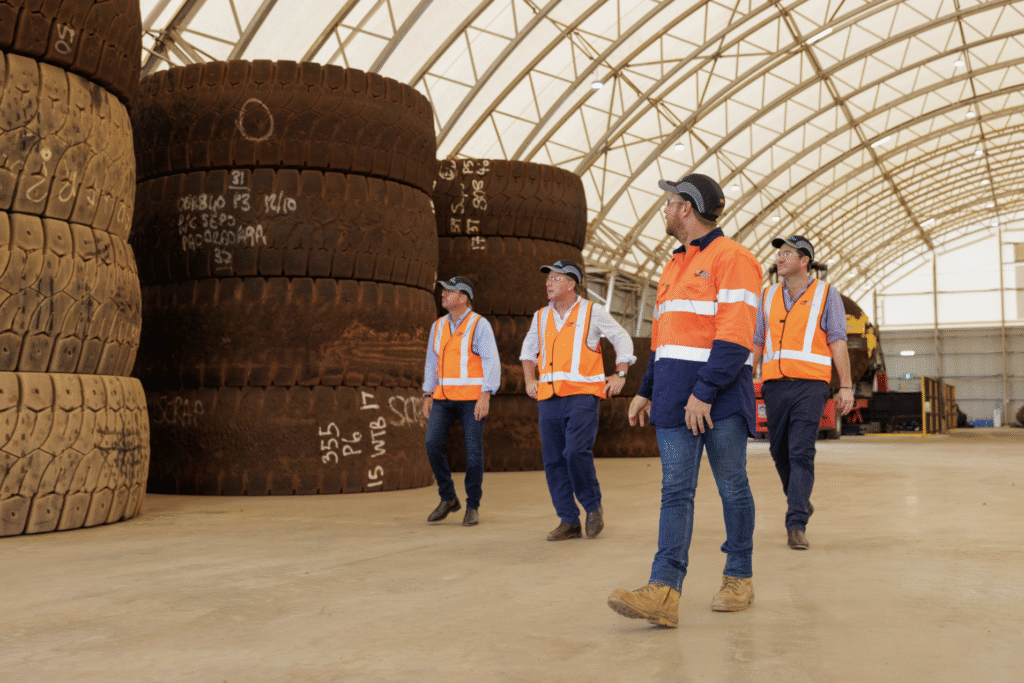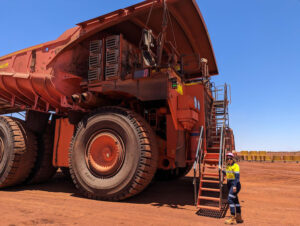In a town best known for its iron ore exports and sheer industrial scale, Port Hedland has just made space for something a little different, though no less important. A dedicated tyre recycling facility, the first of its kind focused solely on OTR mining tyres, has officially opened its doors.
And while it might not be as flashy as a new mine or rail upgrade, it’s a step that could quietly reshape how Australia deals with one of its most stubborn industrial waste problems.
The Problem with OTR Mining Tyres
Let’s be honest OTR mining tyres aren’t just oversized versions of what we put on cars. These things are massive. Sometimes 4 metres tall. They weigh thousands of kilos. And they don’t exactly fit into your average recycling bin.
In mining-heavy towns like Port Hedland, these tyres pile up fast. A single mine can go through hundreds each year. Multiply that by every mining site in Western Australia, and you start to see the scale of the problem. Traditionally, they’ve been buried, stockpiled, or, on rare occasions, shipped overseas. None of those are great options. Not environmentally, and not economically either.
Why Tyre Recycling Matters (Now More Than Ever)
For years, tyre recycling felt like an added benefit. Something you’d see in a sustainability report, maybe, but not something built into the core of mining operations. That’s changing.
There’s a growing pressure both from regulators and from inside the industry itself to find responsible, scalable ways to deal with mining waste. Tyres, especially the massive OTR variety, are high on that list.
They don’t decompose. They take up huge amounts of space. And they’re made of materials that, in the right conditions, can be reused in surprisingly useful ways. Think roads, playground surfaces, even new rubber products.
A New Kind of Facility for an Old Problem
The new site in Port Hedland, run by Tyrecycle and other stakeholders, is designed to handle these massive tyres directly where they’re needed most, at the source. That’s key.
Instead of transporting used tyres thousands of kilometres, they can now be processed locally. It saves on emissions. It cuts down logistical costs. It makes recycling an actual part of the mining process, rather than an afterthought.
According to reports, the facility is set to process up to 30,000 tonnes of mining tyres annually. That might sound small in the grand scheme of global mining, but in regional terms, it’s a big deal.

Image via Tyrecycle
Where to Recycle Old Tires: Why Centralisation Works
For most people, asking where to recycle old tires brings up thoughts of local mechanics. That’s fine for car tyres. But in mining? It’s more complicated.
You need specialist equipment to break down tyres this size. You need safety protocols, trained staff, heavy-duty shredders, and environmental controls. So, centralised hubs like the Port Hedland site have started to make sense.
One site, built properly, can handle thousands of tonnes each year. By focusing on high-use regions, you avoid the “ship-it-out” model that makes recycling less practical and more expensive.
What Happens to the Rubber?
So here’s a question you might not have thought about: What actually happens to these tyres once they’re shredded? The answer is: it depends.
Some get turned into crumb rubber. That’s the small, pellet-like material you’ll see used in synthetic turf, road surfacing, and rubber matting. Others might be pyrolysed, a process where rubber is broken down chemically into fuel, gas, and steel. It’s not exactly glamorous, but it’s efficient.
Not all recycled tyres go into “circular” use-cases (where the rubber becomes another tyre or similar product). But even lower-grade recycling is better than dumping. It offsets resource use, reduces fire risk, and removes a bulky waste stream from the environment.
Is This the Turning Point?
It’s tempting to treat news like this as a definitive turning point. Port Hedland builds a tyre recycling plant. Mining becomes sustainable overnight. But that’s not really how it works.
This project, however, changes the conversation. It says: this can be done. With the right partners, the right funding, and a local focus, tyre recycling can become part of everyday mining operations, not just a line in a report.
And once that happens in one place, it tends to spread.
Conclusion
Port Hedland’s new tyre recycling facility is a great step in the right direction, and it solves a real problem that mining has been ignoring for decades.
This new site proves that we don’t need to wait for perfect solutions. Sometimes, progress starts with a single site, a regional town, and a few very large tyres.







